Gigaset GS110 User Manual
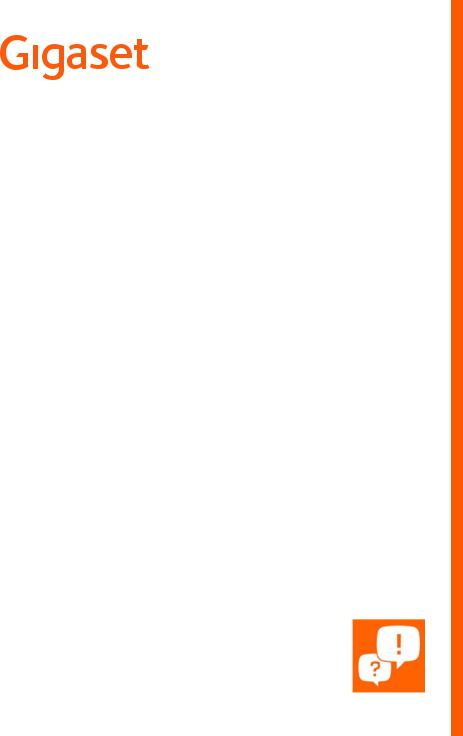
GS110
You can also find the user guide
online on your smartphone

Contents
Contents
Overview . . . . . . . . . . . . . . . . . . . . . . . . . . . . . . . . . . . . . . . . . . . . . . . . . . . . . . . . . . . . . . . . . . . . . . . . . . . . . .3
Gigaset GS110 . . . . . . . . . . . . . . . . . . . . . . . . . . . . . . . . . . . . . . . . . . . . . . . . . . . . . . . . . . . . . . . . . . . . . . . . . 3 Start screen . . . . . . . . . . . . . . . . . . . . . . . . . . . . . . . . . . . . . . . . . . . . . . . . . . . . . . . . . . . . . . . . . . . . . . . . . . . . 4 Illustration in the user guide . . . . . . . . . . . . . . . . . . . . . . . . . . . . . . . . . . . . . . . . . . . . . . . . . . . . . . . . . . . . 5
Safety precautions . . . . . . . . . . . . . . . . . . . . . . . . . . . . . . . . . . . . . . . . . . . . . . . . . . . . . . . . . . . . . . . . . . . . .6 Getting started . . . . . . . . . . . . . . . . . . . . . . . . . . . . . . . . . . . . . . . . . . . . . . . . . . . . . . . . . . . . . . . . . . . . . . . .9 Using the device . . . . . . . . . . . . . . . . . . . . . . . . . . . . . . . . . . . . . . . . . . . . . . . . . . . . . . . . . . . . . . . . . . . . . 13
Getting to know your device . . . . . . . . . . . . . . . . . . . . . . . . . . . . . . . . . . . . . . . . . . . . . . . . . . . . . . . . . . |
13 |
Configuring the start screens . . . . . . . . . . . . . . . . . . . . . . . . . . . . . . . . . . . . . . . . . . . . . . . . . . . . . . . . . . |
20 |
Notifications . . . . . . . . . . . . . . . . . . . . . . . . . . . . . . . . . . . . . . . . . . . . . . . . . . . . . . . . . . . . . . . . . . . . . . . . . . |
23 |
Apps . . . . . . . . . . . . . . . . . . . . . . . . . . . . . . . . . . . . . . . . . . . . . . . . . . . . . . . . . . . . . . . . . . . . . . . . . . . . . . . . . . |
25 |
Downloads . . . . . . . . . . . . . . . . . . . . . . . . . . . . . . . . . . . . . . . . . . . . . . . . . . . . . . . . . . . . . . . . . . . . . . . . . . . |
29 |
“Do not disturb” . . . . . . . . . . . . . . . . . . . . . . . . . . . . . . . . . . . . . . . . . . . . . . . . . . . . . . . . . . . . . . . . . . . . . . . |
29 |
Additional functions . . . . . . . . . . . . . . . . . . . . . . . . . . . . . . . . . . . . . . . . . . . . . . . . . . . . . . . . . . . . . . . . . . |
31 |
Communication . . . . . . . . . . . . . . . . . . . . . . . . . . . . . . . . . . . . . . . . . . . . . . . . . . . . . . . . . . . . . . . . . . . . . 33
Making calls . . . . . . . . . . . . . . . . . . . . . . . . . . . . . . . . . . . . . . . . . . . . . . . . . . . . . . . . . . . . . . . . . . . . . . . . . . 33
Contacts . . . . . . . . . . . . . . . . . . . . . . . . . . . . . . . . . . . . . . . . . . . . . . . . . . . . . . . . . . . . . . . . . . . . . . . . . . . . . . 38
Messages (SMS/MMS) . . . . . . . . . . . . . . . . . . . . . . . . . . . . . . . . . . . . . . . . . . . . . . . . . . . . . . . . . . . . . . . . . 42
Settings . . . . . . . . . . . . . . . . . . . . . . . . . . . . . . . . . . . . . . . . . . . . . . . . . . . . . . . . . . . . . . . . . . . . . . . . . . . . . 46
Device . . . . . . . . . . . . . . . . . . . . . . . . . . . . . . . . . . . . . . . . . . . . . . . . . . . . . . . . . . . . . . . . . . . . . . . . . . . . . . . . 46 Security . . . . . . . . . . . . . . . . . . . . . . . . . . . . . . . . . . . . . . . . . . . . . . . . . . . . . . . . . . . . . . . . . . . . . . . . . . . . . . . 52 Accounts and location detection . . . . . . . . . . . . . . . . . . . . . . . . . . . . . . . . . . . . . . . . . . . . . . . . . . . . . . 58 Apps . . . . . . . . . . . . . . . . . . . . . . . . . . . . . . . . . . . . . . . . . . . . . . . . . . . . . . . . . . . . . . . . . . . . . . . . . . . . . . . . . . 61 Network connections . . . . . . . . . . . . . . . . . . . . . . . . . . . . . . . . . . . . . . . . . . . . . . . . . . . . . . . . . . . . . . . . . 64 System . . . . . . . . . . . . . . . . . . . . . . . . . . . . . . . . . . . . . . . . . . . . . . . . . . . . . . . . . . . . . . . . . . . . . . . . . . . . . . . . 75
Appendix . . . . . . . . . . . . . . . . . . . . . . . . . . . . . . . . . . . . . . . . . . . . . . . . . . . . . . . . . . . . . . . . . . . . . . . . . . . . 79
Customer service United Kingdom and Ireland . . . . . . . . . . . . . . . . . . . . . . . . . . . . . . . . . . . . . . . . . 79 Customer Service & Assistance . . . . . . . . . . . . . . . . . . . . . . . . . . . . . . . . . . . . . . . . . . . . . . . . . . . . . . . . . 80 Manufacturer's advice . . . . . . . . . . . . . . . . . . . . . . . . . . . . . . . . . . . . . . . . . . . . . . . . . . . . . . . . . . . . . . . . . 82 Icons . . . . . . . . . . . . . . . . . . . . . . . . . . . . . . . . . . . . . . . . . . . . . . . . . . . . . . . . . . . . . . . . . . . . . . . . . . . . . . . . . 85
Index . . . . . . . . . . . . . . . . . . . . . . . . . . . . . . . . . . . . . . . . . . . . . . . . . . . . . . . . . . . . . . . . . . . . . . . . . . . . . . . . 87
Not all functions described in the user guide are available in all countries or from all network providers.
2
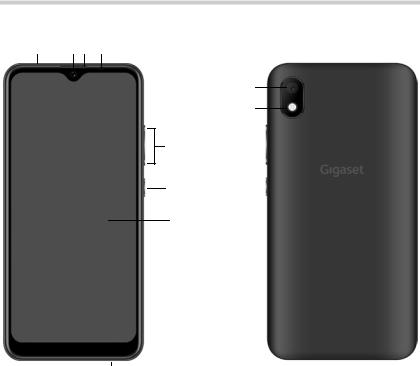
Gigaset GS110
Overview
Gigaset GS110
1 |
2 3 |
4 |
11
12
5
6
7
|
|
|
|
|
8 |
|
|
|
|
|
|
|
|
|
9 |
|
|
|
|
|
|
|
10 |
|
|
|
|
|
|
|
|
|
|
||
1 |
Headset connector (3.5 mm jack) |
11 |
Back camera |
|||||
2 |
Front camera |
12 |
Flash |
|||||
3Receiver
4Light / proximity sensor
5 Volume button (top: +, bottom: –)
6 On/Off key
7Touch screen
8Speaker
9 USB type C connector
10 Microphone
3
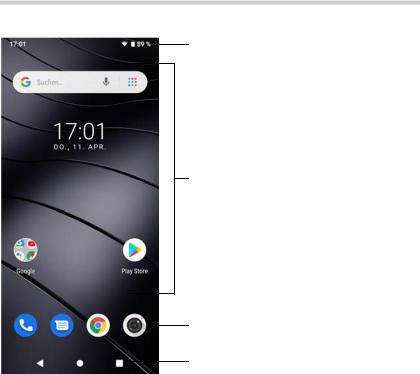
Start screen
Start screen
Notifications and Status bar
Icons show the arrival of notifications and various states ( p. 85)
p. 85)
Access to notifications ( p. 23)
p. 23)
Access to quick settings ( p. 17)
p. 17)
Area for apps and widgets
They can be placed anywhere ( p. 20)
p. 20)
Favourites bar
Frequently used apps ( p. 20)
p. 20)
Navigation buttons ( p. 16)
p. 16)
4
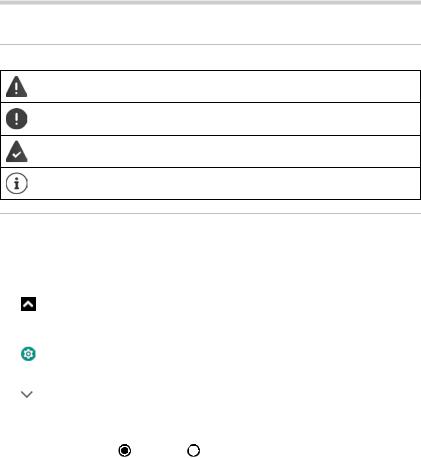
Illustration in the user guide
Illustration in the user guide
Icons
Warnings, the non-adherence to which can result in damage to devices or personal injury.
Important information regarding function and appropriate handling or functions that could generate costs.
Prerequisite for carrying out the following action.
Additional helpful information.
Procedures
Example: Change the time for transitioning to the idle status
¤ 

 Settings
Settings  Display
Display 
 Advanced
Advanced  Sleep
Sleep  Select time
Select time
Step |
|
Follow this procedure |
|
|
|
|
|
¤ |
|
Swipe the start screen up |
|
|
|
Note: You can skip this step if the app you want to open is on a |
|
|
|
start screen. |
|
|
|
|
|
¤ |
Settings |
Tap the Settings app. The Settings menu opens. |
|
¤ Display |
Tap the menu entry Display. |
||
¤ |
Advanced |
Tap Advanced. Further settings are displayed. |
|
¤ Sleep |
Tap Sleep. |
|
|
¤ Select time |
Tap the required time |
||
|
|
= Selected, |
= Not selected |
|
|
|
|
5
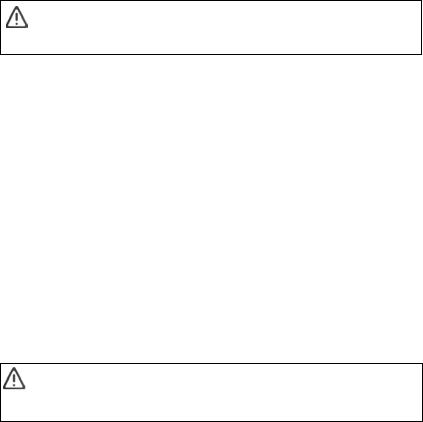
Safety precautions
Safety precautions
Please read these instructions carefully. Failure to comply presents a risk of injury and damage to a device, as well as breaches of applicable laws.
Please explain the contents of this document as well as the potential risks associated with using this device to your children.
General information
•For your own safety, only use original, approved accessories from Gigaset for your mobile phone. Using incompatible accessories can damage the mobile phone and entail hazardous situations. Original accessories can be purchased from Gigaset Customer Service (see Customer service United Kingdom and Ireland  p. 80).
p. 80).
•The mobile phone is not waterproof. The device or its accessories must therefore not be kept or charged in damp environments (in bathrooms, shower rooms or kitchens, for example). Rain, moisture or any liquid can contain minerals which can cause the electrical circuitry to corrode. There is a risk of electric shock, fire or damage when the device is being charged.
•Permitted temperature range for charging and operation: 0-40°C.
High temperatures can shorten the life of electronic devices and damage the battery; plastic parts can deform or melt. Using or keeping the mobile phone in refrigerated areas can result in condensation on the inside of the telephone which will destroy the electronic circuitry.
•The mobile phone must not be used or kept in dusty or dirty places. Dust can be a reason for the mobile phone to malfunction.
•Switch off your mobile phone when in potentially explosive areas and observe all warning signs. Potentially explosive areas also include places where switching off vehicle engines is normally recommended. It is at these kinds of places that flying sparks can be the cause of explosions or fires with resulting injuries, and there may be a risk to life.
These areas include petrol stations, chemical factories, transport and storage systems for hazardous chemicals, spaces under ship decks, areas in which the air contains chemical substances or fine particles (such as dust or metal powder particles).
•Short-circuiting, disassembling and modifying the mobile phone are not permitted because they present a risk of injury, electric shock, fire or damage to the charger.
•The USB connection must be established with USB version 2.0 or higher.
Battery and charging
Only use batteries approved and certified by Gigaset. Original accessories are available from Customer Service at Gigaset.
Not replacing the battery properly can pose a risk of explosion.
Dispose of used batteries in line with the instructions (Chapter Waste and environmental protection  p. 83).
p. 83).
•Never burn or heat batteries, and do not dispose of them in environments which are at risk of heat or fire to prevent battery fluid escaping, overheating, explosion and fire. Do not disassemble, weld and/or modify the battery. Do not keep the battery where it is exposed to strong mechanical effects.
•Do not use any sharp objects (such as screwdrivers) to touch or pierce the battery. There is a risk that battery fluid will escape or the battery will overheat, explode or catch fire and burn. Crushing, heating and burning batteries are strictly prohibited.
•The battery electrolyte coming into contact with eyes can cause a loss of eyesight. If electrolyte does enter an eye, please do not rub the eye with a hand. Immediately wash the affected eye thoroughly with clear water and consult a doctor. The electrolyte coming into contact with skin (or clothing) presents a risk of skin burns. Immediately wash the skin or clothing thoroughly with soap and clear water, and consult a doctor if required.
•Never use batteries for purposes other than those specified. Never use a damaged battery. If the battery becomes hot, discolours, deforms or becomes leaky whilst being used, charged or kept in a safe place, it must be replaced immediately by a new battery for safety reasons.
•The battery temperature rises during the charging process. Do not keep the battery together with ignitable products in the same drawer as this poses a risk of fire.
•Do not charge the battery for longer than 12 hours.
6

Safety precautions
•Only charge the device indoors. Whilst the phone is charging, do not use the phone for calls or dial any numbers.
•The socket must be easily accessible during the charging process.
•Electrical storms pose a risk of electric shocks.
•Do not use the charger when the power cable is damaged or no battery is inserted in the mobile phone because this poses a risk of electric shock and fire.
Headset
High volumes can impair hearing. Listening to music or conversation with headphones set to a loud volume can be unpleasant and permanently impair hearing.
To prevent loss of hearing, do not have the volume turned up too high for long periods.
•If you wear headphones whilst out walking or running, please ensure that the cord does not wrap itself around your body or objects on your person.
•Only wear headphones in dry environments. The static electricity which builds up on the headphones can discharge via your ears as an electric shock. The static electricity can discharge if you touch the headphones with your hand or touch bare metal before connecting with the mobile phone.
Use in hospitals / medical devices
•The function of medical equipment near your product can be impaired. Bear in mind the technical conditions of the environment in question (such as in doctors’ surgery).
•If you use a medical device such as a pacemaker, please consult the manufacturer of the product before using your mobile phone. You will be provided information on the sensitivity of the device to external, high-frequency energy sources.
•Heart pacemakers, implantable cardioverter defibrillators:
When you switch on your mobile phone, ensure that the distance between the phone and an implant is at least 152 mm. To reduce potential interference, use the mobile phone on the opposite side to the implant. Please switch the mobile phone off immediately if interference occurs. Do not keep the mobile phone in a shirt pocket.
•Hearing aids, cochlear implants:
Some digital wireless devices can interfere with hearing aids and cochlear implants. Please consult the manufacturers of these products if interference occurs.
•Other medical devices:
If you and the people around you use other medical devices, please contact the relevant manufacturer for information on whether such devices are protected from radio frequency signals in the environment. You can also consult your doctor about this.
Emergency calls
•Make sure the mobile phone is switched on and connected to the GSM network. Enter the emergency number as required and speak.
•Tell the person at the emergency call centre your location.
•Do not end the conversation until the person at the emergency call centre asks you to.
Children and pets
•Keep the mobile phone, batteries, chargers and accessories out of the reach of children and pets. Children and/or pets can swallow the small parts, posing a risk of suffocation and other hazards. A child may only use the mobile phone under the supervision of an adult.
Playing games
•Playing games on the mobile phone for long periods may mean assuming an unhealthy body posture. Take a 15 minute break every hour. Stop immediately if you feel unwell during game play. Consult a doctor straight away if your condition persists.
7
Safety precautions
Aeroplanes, vehicles and road safety
•Switch off your mobile phone in aeroplanes
Please observe applicable restrictions and regulations.
Wireless devices can interfere with the function of aeronautical equipment. Follow the instructions issued by flight personnel when using your mobile phone.
•The absolute priority for every vehicle driver and everyone in a vehicle is safety on the roads and for road users.
Using a mobile phone whilst driving can be distracting and therefore lead to dangerous situations. You can also be violating applicable laws.
SIM card, memory card and data connector cable
•Do not remove the card from the mobile phone whilst data is being sent or received as this presents a risk of data loss and damage to the mobile phone or memory card.
•Charges might apply when establishing Internet connections via the SIM card.
Defective devices
•The installation and repair of products are the sole preserves of qualified maintenance personnel.
•Dispose of faulty devices or have them repaired by our Customer Service team. These devices could interfere with other wireless services.
•Careless handling of the mobile phone, such as dropping it, can shatter the display and damage the electronic circuitry and sensitive parts inside.
•Do not use the device if the display is cracked or shattered. Fragments of glass or plastic can injure hands and face.
•In the event of malfunction of your mobile phone, battery or accessories, please contact a Gigaset Service Centre for an inspection.
Other important information
•Never point the flash light directly at the eyes of people or animals. Pointing a flash light too near to human eyes poses a risk of temporary loss of eyesight or impairment of vision.
•The device can heat up when running power-intensive apps or programs for longer periods. This is normal and has no bearing on the performance of the device.
•When the device warms up, please put it aside for a while and stop the program you were running. Coming into contact with a hot device can cause minor skin irritations such as redness.
•Do not apply lacquer to the mobile phone. Lacquer and paint can damage the parts of the mobile phone and may cause malfunction.
8
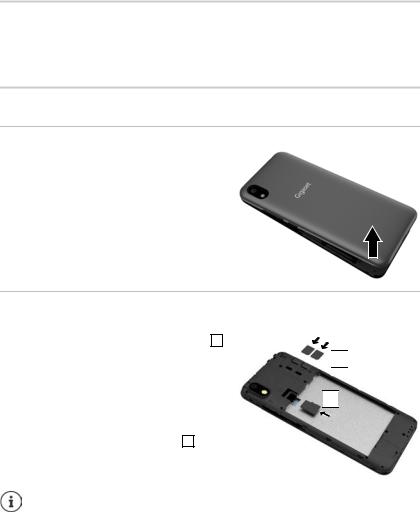
Getting started
Getting started
Contents of the package
•A Gigaset GS110 smartphone
•A battery
•A charger cable with power adapter
Getting started
Opening the device
¤Place your fingernail under the cover at one of the bottom corners and pull the cover up.
Inserting SIM and SD cards
You can insert two nano SIM cards and one micro SD card in the smartphone.
¤Insert nano SIM card(s) into the SIM card slot 1 and push it/them backwards.
Inserting an SD card (optional)
To store personal data, photos, videos and music, you can insert a MicroSD card into the smartphone.
¤Insert a MicroSD card into the SD slot 3 and push it backwards.
 1
1 
 2
2 
The device detects SD cards with a storage capacity of 32 GB. Higher capacity cards (to 256 GB) can be used if formatted on the Gigaset GS110 (not from a PC).
9
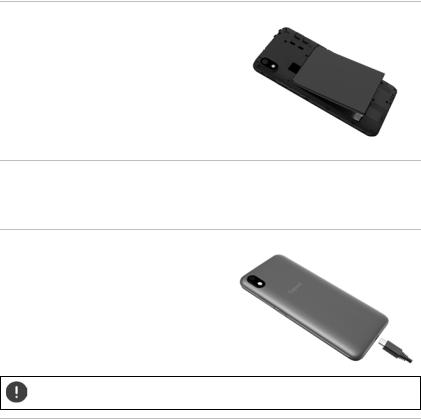
Getting started
Inserting the battery
¤Insert the battery into the device with the connector contacts facing forwards  Insert the battery downwards into the battery compartment.
Insert the battery downwards into the battery compartment.
Removing the battery:
¤To change the battery, place your fingernail into the recess on the battery compartment and pull the battery up.
Closing the cover
¤Align the cover with the side tabs on the slots on the inside of the casing.
¤Press the cover until it clicks into place.
Charging the battery
¤Plug the USB Type C connector on the charger cable provided into the USB Type C connector on the smartphone
¤Connect the power adapter to the USB connector of the charger cable and connect it to the power source.
The device is charged once the charge icon  in the Status bar is filled completely.
in the Status bar is filled completely.
So your phone does not discharge during set-up, keeping it connected to the power is recommended until set-up is complete.
Switching on the device
¤Keep the On/Off button pressed until the device vibrates. When you are requested to unlock the SIM card,
¤ use the keypad to enter the PIN of the SIM card
use the keypad to enter the PIN of the SIM card 

When switching on the device for the first time, a wizard starts which guides you through the initial configuration.
10

Getting started
Wizard for configuring the device
When you switch on your phone for the first time, you are automatically guided through the most important configuration steps.
< |
Back: Check and change as required settings already configured. |
Next > |
Apply the setting on the screen and jump to the next screen. |
Skip |
Configure the setting later. |
Selecting the language
The set language is displayed.
¤ Select another language as required  tap Start
tap Start
Inserting SIM cards
This screen is only shown when no SIM card is inserted:
¤ Insert card now ( p. 9) Insert SIM card later:
p. 9) Insert SIM card later:  Skip
Skip
Establishing a WLAN connection
Wireless networks (WLANs) in range are displayed.
¤Tap the required WLAN 
 Enter the WLAN password
Enter the WLAN password  Connect . . . A connection to the selected WLAN is established
Connect . . . A connection to the selected WLAN is established
Copying apps & data
You can now specify whether you want to set up the device as a completely new device or if you want to copy personal data (e. g. apps, photos, music) from another device or from
GoogleTM Cloud.
Copying data
You already have an Android smartphone, a Google account or an iPhone.
¤Select the required option  Select the desired data source
Select the desired data source
¤Follow the instructions on the screen.
Setting up a new device
Logging in to an existing Google account
¤  Enter the email address and password of your Google account
Enter the email address and password of your Google account
or
11

Getting started
Creating a new account
¤Tap Create account 
 Enter the email address and password for a new Google account.
Enter the email address and password for a new Google account.
¤Specify more details to conclude setting up the Google account.
Using Google services
Various services are displayed.
¤ Use the switch to enable/disable the service you want to use  Next
Next
Performing this step also means you accept the conditions of use and data protection declaration of Google.
Setting up protection for the phone
Protect your smartphone from unauthorised use.
¤ Enter the PIN
or
¤Select Options for the display lock
¤Select Pattern | PIN | Password  Next
Next
¤Enter the pattern, PIN or password  Next
Next  Repeat
Repeat  Confirm
Confirm
Enabling Google Assistant
Google Assistant answers questions and carries out a range of tasks. This page provides information about the authorisations required for Google Assistant.
If you want to enable Google Assistant:  Tap Yes, enable.
Tap Yes, enable.
If you do not want to enable Google Assistant:  Tap No, thank you.
Tap No, thank you.
The data used for these settings can be taken from any device logged into the Google account. You can change these settings any time in your Google account at myaccount.google.com.
Setting up other functions
You can now configure other settings, such as set up Google Pay, set the background for the display or the font, and set up another email account.
Gmail is set up once you log in to your Google account. If you set up email addresses for other email accounts, these emails can also be displayed in the Gmail app.
¤ Select provider 
 Enter access details
Enter access details  Next
Next
If you do not want to configure any more settings now:  Done!
Done!
Your smartphone is now ready to use.
12

Getting to know your device
Using the device
Getting to know your device
Switching the device on and off
Switching on
¤ Press and hold the On/Off button . . . The device is started
Unlocking the SIM card
¤  Enter the PIN for the SIM card
Enter the PIN for the SIM card 

Removing notifications (if available)
Clear notification: ¤ Swipe to the left or right
Deal with notification later: ¤ Swipe upwards to the Notifications bar
Notifications  p. 23
p. 23
When a display lock is set up to protect against unauthorised use
¤ Swipe up  Unlock the display . . . The start screen is displayed
Unlock the display . . . The start screen is displayed
Display lock:  p. 52
p. 52
Switching off |
|
¤ Press and hold the On/Off button Tap |
Power off OK |
You can also switch the smartphone to Airplane mode. This only disables the wireless functions, the other device functions remain available.
Scheduled switch-on/off
You can switch the smartphone off and back on at a certain time.
Enabling/disabling scheduled switch-on/off |
||
¤ |
Settings |
Scheduled power on/off Select the checkbox next to the option |
|
required (set time for power on | set time for power off) . . . the smartphone is switched on/ |
|
|
off at the time currently set |
|
Setting the time |
|
|
¤ |
Settings |
Scheduled power on/off Touch the required option Tap Time |
|
Select the time OK |
Tap Repeat Select the days for which the settings apply OK |
|
DONE |
|
13

Getting to know your device
Switching the device to and ending idle mode
Switching the device to idle mode
¤ Briefly press the On/Off button
If the device is not used for a defined time, it automatically switches to idle mode.
Setting the period of inactivity for transitioning to idle mode
¤ 

 Settings
Settings  Display
Display 
 Advanced
Advanced  Sleep
Sleep  Select period
Select period
Ending idle mode
¤Briefly press the On/Off button  Remove any notifications as required
Remove any notifications as required  Swipe up
Swipe up  Unlock the display
Unlock the display
Accessing the smartphone by cancelling idle mode
If you want to take a look at the time, notifications or other information whilst the smartphone is in idle mode, enable the following function.
¤ 

 Settings
Settings  Smart controls
Smart controls  Enable Lift to check phone with the switch
Enable Lift to check phone with the switch
Using the touchscreen
Movements and gestures for using the touchscreen:
Tapping
¤ Briefly touch the screen with your finger
Examples:
Start an app, and select function or setting:  tap the element
tap the element
Enter text:  Tap a text field . . . A keypad is shown
Tap a text field . . . A keypad is shown
Touching and holding
¤ Keep your finger on an element until it responds.
Dragging and releasing
¤Touch and hold the element  Move your finger across the screen to the place required
Move your finger across the screen to the place required  Release the element
Release the element
Example: Moving apps on the start screen
Swiping or dragging
¤ Move your finger quickly across the screen without stopping Example: Switching between the start screens
Double tapping
¤ Tap the screen twice quickly in succession.
14
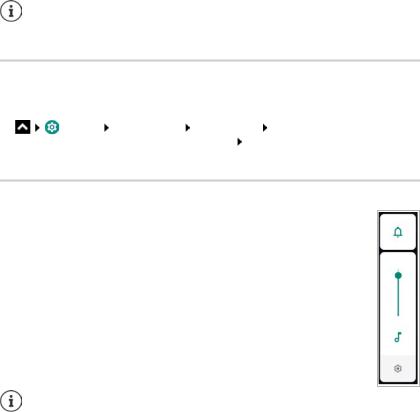
Getting to know your device
Example: Zooming. Only possible for special screens (such as websites or maps). |
||
Zoom in: |
¤ |
Tap twice quickly in succession |
Zoom back out: |
¤ |
Tap twice again |
Spreading apart / pinching together your fingers
¤ Place two or more fingers on the screen at the same time Zoom in: ¤ Spread your fingers apart Zoom out: ¤ Pinch your fingers together
Example: Scaling screen content. Only possible for special screens (such as Google Maps and Chrome).
Prevent unintentional operation by touching when the smartphone is in a pocket:
¤ 

 Settings
Settings  Smart controls
Smart controls  Pocket mode
Pocket mode  Enable function Touch disable with the switch
Enable function Touch disable with the switch
Operating the device using movements
Some functions can be used by picking up, turning or shaking the device. For this, you must enable the Smart motion function and activate the required actions.
¤ |
Settings Smart controls Smart motion Enable the function with the |
|
switch . . . the possible actions are now displayed activate the required actions with the |
|
switch |
Setting volume and vibration from the Volume button
Change the volume for ringtone, music and alarm.
¤Press the Volume button on the right-hand side of the device . . . the slider bar for the volume is opened  Adjust the volume with the slider bar
Adjust the volume with the slider bar
Disabling the ringtone
¤ Drag the slider bar all the way down
or:  Tap
Tap 
Enabling/disabling vibration and muting
¤Tap  . . . the ringtone is disabled; vibration is enabled
. . . the ringtone is disabled; vibration is enabled
¤Tap  . . . vibration is disabled; the ringtone is disabled
. . . vibration is disabled; the ringtone is disabled
¤Tap  . . . the ringtone is enabled
. . . the ringtone is enabled
Configuring advanced audio settings:
¤ Tap  . . . menu Settings – Audio profiles opens (
. . . menu Settings – Audio profiles opens ( p. 47)
p. 47)
15
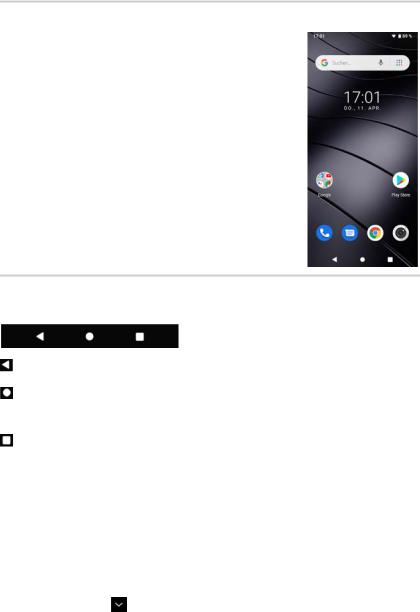
Getting to know your device
Start screen
A start screen is displayed when you switch on or unlock the device, and no app is open.
You can create several start screens and configure them as you wish - to be able to quickly access favourite apps and content ( p. 20).
p. 20).
Returning to the start screen from any user situation
¤Tap the Home button  in the navigation bar . . . the start screen open most recently is displayed
in the navigation bar . . . the start screen open most recently is displayed
Switching between start screens
¤ Swipe left or right to the required start screen.
Switching between start screens and apps
At the bottom of every screen are three Navigation buttons:
Opens the screen last viewed. You can go back several times (only as far as the start screen).
Home button
Briefly tap to: Open the start screen which was open last time.
Touch and hold to: Open the Google Assistant  Google-Hilfe
Google-Hilfe
Opens an overview of the apps and browser tabs used last time.
Open an app: ¤ Tap it
Close an app: ¤ Swipe the app left or right
Customising the navigation bar
¤ 

 Settings
Settings  Navigation bar
Navigation bar
Showing/hiding the navigation bar
¤Enable/disable Show/hide navigation bar with the switch
( = navigation bar is displayed;
= navigation bar is displayed;  = navigation bar is hidden)
= navigation bar is hidden)
When the navigation bar is hidden: |
||
Display: |
¤ |
Swipe from the bottom up |
Hide: |
¤ |
Tap |
16

Getting to know your device
Changing the order of the navigation buttons
Swap the positions of navigation buttons  and
and  .
.
¤ Choose an appropriate combination, e.g.
Adding a button to open the notification and status bar
¤ Choose a combination with the  symbol, e.g.
symbol, e.g.
Quick settings
The quick settings enable you to access frequently used settings from all user situations, such as screen lighting, WLAN, Bluetooth and similar settings.
Opening the quick settings
¤ From the Status bar, swipe down
or, when the  symbol is available in the navigation bar:
symbol is available in the navigation bar:
¤ Tap 
. . . The most important quick settings are displayed
¤Swipe down again . . . More quick settings are displayed  Swipe left/right to display all the quick settings
Swipe left/right to display all the quick settings
Icons of the quick settings  p. 85
p. 85
Enabling and disabling a function
¤Tap the setting . . . The symbol for the setting is coloured when it is enabled, and grey when it is disabled
Changing a setting
¤ Touch and hold the symbol  Change the setting as required
Change the setting as required
Editing quick settings
You can make available more quick settings, remove any not used and rearrange the icons.
¤Tap  . . . Quick settings not being used are shown at the bottom
. . . Quick settings not being used are shown at the bottom  Touch and keep your finger on the icon, and drag it to the required position
Touch and keep your finger on the icon, and drag it to the required position
Finish editing:  Tap
Tap  in the top left
in the top left
Restore to default settings:  Tap
Tap
 Reset
Reset
The required setting is not available as a quick setting:
¤Tap  . . . the Settings app is opened; here you can access all of your smartphone settings.
. . . the Settings app is opened; here you can access all of your smartphone settings.
17

Getting to know your device
Writing and editing text
Use the Google keypad to write text.
Opening the keypad
¤ Tap a place where text can be entered
You can enter letters, digits and special characters.
Switching between entry of letters and digits / special characters:  Tap
Tap 
Closing the keypad
¤ Tap  in the navigation bar
in the navigation bar
Adding text
Entering letters and symbols: |
¤ Tap a key |
|
Entering uppercase letters: |
¤ |
Tap the shift key ( ) |
Enabling/disabling Caps Lock: |
¤ |
Double tap the shift key ( ) |
Showing umlauts: |
¤ |
Touch and hold the key |
Whilst text is being entered, suggestions from the keypad dictionary are shown above the keypad.
Using a suggestion: |
¤ Tap the word . . . The word is included and a space is inserted |
||
|
|
automatically |
|
|
|
|
|
Editing text |
|
|
|
Positioning the cursor: |
¤ Tap the place in the text where you want to position the |
||
|
¤ |
cursor |
|
Moving the cursor: |
Swipe left or right on the text |
||
Deleting a character: |
¤ |
Touch and hold the backspace key |
|
Selecting text: |
¤ |
Touch and hold a word |
Select more or less text with tabs |
|
¤ |
on both sides |
|
Selecting all: |
Touch and hold a word |
Select all |
|
Cutting selected text: |
¤ |
Tap Cut |
|
Copying selected text: |
¤ |
Tap Copy |
|
Pasting text: |
¤ |
Position the cursor Tap on the cursor Paste |
|
If there is not enough of space to display all options:  Tap
Tap 
18

Getting to know your device
Changing the keypad settings
You can change various keypad settings, such as the language for the keypad assignment, the response to keypresses and the keypad design.
¤ 

 Settings
Settings  System
System  Languages & input
Languages & input  Virtual keyboard
Virtual keyboard  Gboard
Gboard
Setting voice entry
If an app permits it, you can also enter text by speaking into the microphone. The function is enabled by default.
Enable/disable voice input: |
|
|
|
||
¤ |
Settings |
System |
Languages & input |
Virtual keyboard |
Manage |
|
keyboards Enable/disable Google Voice input with the switch |
|
|||
Voice input settings: |
|
|
|
|
|
¤ |
Settings |
System |
Languages & input |
Virtual keyboard |
Google Voice |
input
19
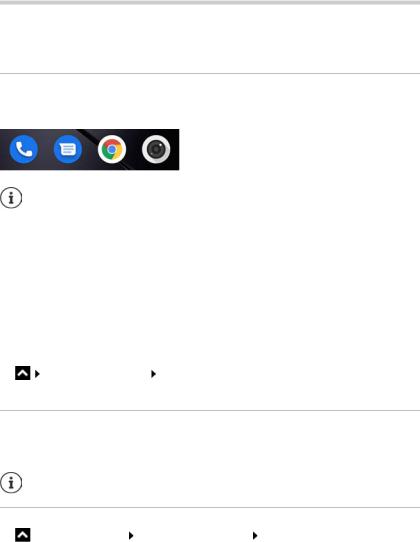
Configuring the start screens
Configuring the start screens
You can create several start screens and configure them as you wish - to be able to quickly access favourite apps and content.
Tailoring the Favourites bar
At the bottom of every start screen is the Favourites bar, from which you are able to quickly access the apps you use most frequently.
Opening the menu with all the apps:
¤
The apps in the App menu are in alphabetical order.
Scrolling through the list:  swipe up or down
swipe up or down
Removing apps from the Favourites bar
¤Touch an app in the Favourites bar and drag it upwards
¤Drag the app to the Forget button at the top of the screen and release your finger
or
¤Drag it to somewhere else on the screen and release your finger
Adding an app |
|
¤ |
Select the required app Touch and hold the app . . . The start screen is shown in the |
background  Drag the app to a free space in the Favourites bar and release your finger.
Drag the app to a free space in the Favourites bar and release your finger.
Changing the wallpaper
¤Touch and hold the wallpaper  Tap Wallpapers
Tap Wallpapers  Select picture from the predefined backgrounds or a separate photo from the photo gallery
Select picture from the predefined backgrounds or a separate photo from the photo gallery  Tap Choose wallpaper from
Tap Choose wallpaper from
More wallpaper images can be downloaded from Google Play.
Adding an app to a start screen |
|
¤ |
Open the App menu Look for the required app Touch and drag the app . . . The start |
screen is displayed in the background  Drag the app to a free space in a start screen and release your finger
Drag the app to a free space in a start screen and release your finger
20

Configuring the start screens
Adding a widget to a start screen
Widgets are components that are specifically intended to be displayed on a start screen,
e.g. a clock, a calendar extract for the current day, an important entry from the contact list or a direct dial.
¤Touch and hold a free space on a start screen  Tap Shortcuts
Tap Shortcuts
¤Touch and hold the required widget . . . The start screen is displayed in the background  Drag the widget to a free space in a start screen and release your finger
Drag the widget to a free space in a start screen and release your finger
The sizes of some widgets can be changed:
¤Touch and hold a widget  Release your finger . . . If the size of the widget can be changed, you see a dotted frame on the edges
Release your finger . . . If the size of the widget can be changed, you see a dotted frame on the edges  Change the size of the widget by dragging the dots
Change the size of the widget by dragging the dots
Once the correct size is set:  Tap anywhere outside the widget
Tap anywhere outside the widget
Moving apps and widgets
¤Touch and hold an app or widget on a start screen  Drag the app or widget to the required position and release your finger, or drag it to the left or right to another start screen and release your finger
Drag the app or widget to the required position and release your finger, or drag it to the left or right to another start screen and release your finger
Creating folders for apps
¤Touch and hold an app on a start screen  Drag the app icon over another app icon . . .
Drag the app icon over another app icon . . .
A shared symbol is created for both apps
Adding apps:
¤Touch and hold an app  Drag it to the folder To remove the app:
Drag it to the folder To remove the app:
¤Open folder  Touch and hold the app
Touch and hold the app  Drag it from the folder to the background
Drag it from the folder to the background
Renaming a folder:
¤Open the folder  Tap the name . . . The keypad opens
Tap the name . . . The keypad opens  Delete the old name
Delete the old name 
 Enter the new name
Enter the new name 

Removing an app or widget
¤Touch and hold an app or widget on a start screen  Drag it up to option Remove and release your finger
Drag it up to option Remove and release your finger
Adding, rearranging and removing start screens
If you have created multiple start screens, a fine white bar will appear above the Favourites bar when you swipe left or right, displaying the number of start screens and the position of the current start screen.
21
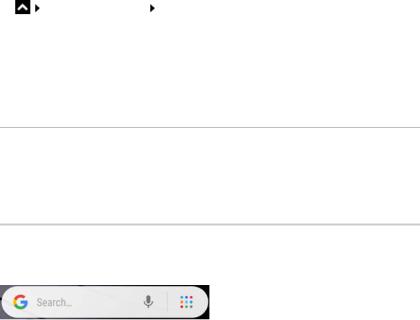
Configuring the start screens
Adding start screens |
|
¤ |
Touch and hold an app Drag the app all the way to the right until a blank start |
screen is shown  Release your finger . . . A new start screen is created and the app is placed on it
Release your finger . . . A new start screen is created and the app is placed on it
Removing a start screen
¤Remove all apps and widgets from a start screen (by deleting them or moving them to another start screen) . . . When the last app or widget has been removed, the start screen is deleted
Other settings for the start screen
You can configure other settings for the design of the start screen, such as the appearance of the app symbols.
¤Touch and hold a free place on a start screen  Tap Home settings
Tap Home settings  Select the required option and set it if required
Select the required option and set it if required
Browse smartphone and Internet
You can add the Google search widget to the start screen so you can search on your smartphone or browse the Internet.
Entering a search term
¤ Tap the Search bar 
 Enter a search term using the keypad
Enter a search term using the keypad 

Search using voice entry
¤ Tap the Microphone icon 
 Speak your search term into the microphone Additional information
Speak your search term into the microphone Additional information  Google Help
Google Help
Searching with Google Go
Google Go makes available some apps that need less memory and save data volume compared to standard Google apps ( p. 27). The Google Go app is also offered in the Search widget.
p. 27). The Google Go app is also offered in the Search widget.
¤ Tap the  icon
icon  Tap
Tap 
22

Notifications
Notifications
Notifications inform you about various events, such as the arrival of a new voice message or email, appointments or wake-up calls.
Notifications are displayed as follows:
•In the Notifications bar:  Swipe over the screen from the top down
Swipe over the screen from the top down
An icon in the Notifications bar denotes which notifications are available ( p. 85).
p. 85).
•On the lock screen: when the phone starts and when returning from idle mode
•At the top of the screen whilst you are doing something else on your phone, such as reading an email or watching a video
•Briefly on the idle screen
Changing the settings for displaying notifications:  p. 24
p. 24
You can place into the navigation bar a button  for quickly displaying the notification bar (
for quickly displaying the notification bar ( p. 16).
p. 16).
Dealing with notifications
Viewing and responding to notifications
¤Tap the notification . . . The contents of the message are displayed in the associated app. If there are several possible apps, you can select one.
Which information is displayed and which actions are possible depend on the app which triggers a notification.
Some apps allow actions to respond to a notification. You can for example reply directly to a mail, switch off a wake-up call or show on the map the meeting place for an appointment.
Changing the display options of the app for notifications:  p. 24
p. 24
Deleting and resetting notifications
Deleting a notification:
¤ Swipe the notification to the left or right
Deleting all notifications on the Notifications screen:
¤ Scroll down to the end of the notifications  Clear all
Clear all
Resetting a notification on the lock screen or at the top of the screen to read it later:
¤
Show most recent incoming notifications
¤ 

 Settings
Settings  Apps & notifications
Apps & notifications  Notifications
Notifications
Listed in Recently sent are the apps that sent the most recent notifications.
23

Notifications
Settings for notifications
Changing the default notification sound
¤ 

 Settings
Settings  Apps & notifications
Apps & notifications  Notifications
Notifications  Default notification
Default notification
sound  Select the source for ringtones (media storage or own ringtones)
Select the source for ringtones (media storage or own ringtones)  Select the notification tone
Select the notification tone  OK
OK
or
¤ 

 Settings
Settings  Audio profiles
Audio profiles  General
General  Edit
Edit  Default notification sound
Default notification sound 
Select the notification tone  OK
OK
No notification sound:  Select None (first entry in the list)
Select None (first entry in the list)
•If you do not wish to be disturbed, you can mute your device. No notification sound is then played.
Use the “Do not disturb” function to mute your device  p. 29
p. 29
•In some apps, sound and vibration settings for notifications can be set directly in the app from the Settings menu.
•If the volume for the ringtone is reduced down to Vibration mode ( p. 48), the device vibrates for notifications instead of playing a sound. The smartphone continues to vibrate for notifications for which Vibration mode is already selected.
p. 48), the device vibrates for notifications instead of playing a sound. The smartphone continues to vibrate for notifications for which Vibration mode is already selected.
Changing the settings for app notifications
Specify how and when notifications for an app are displayed
¤ 

 Settings
Settings  Apps & notifications
Apps & notifications  Display all apps
Display all apps  Select an app
Select an app 
Notifications
or
¤ Touch and hold an app notification  Tap
Tap 
 Notifications
Notifications
The possible app notifications are displayed. You can specify which app notifications are displayed.
Notifications on the lock screen
The following settings are available for the lock screen:
•Don't show notifications at all
•Show all notification content
•Hide sensitive content
You can use this setting as the default for all apps. |
|
¤ |
Settings Apps & notifications Notifications On lock screen Select the |
required option
or
¤ 

 Settings
Settings  Security & location
Security & location  Lock screen settings
Lock screen settings  On lock screen
On lock screen
24
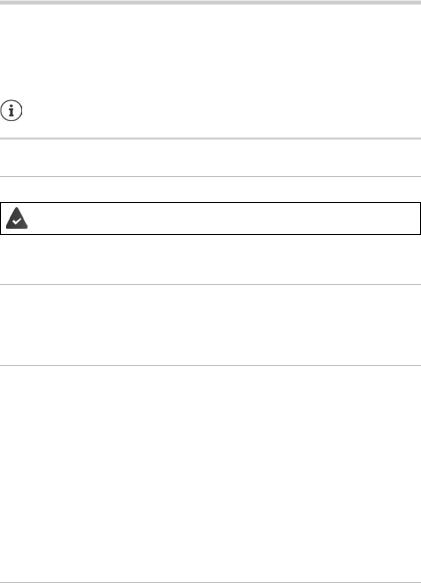
Apps
Apps
The apps available on the device are stored in the App menu. The device is supplied with a number of default apps. Additional apps from your mobile operator are installed as soon as you insert a SIM card.
You can download and install more apps, or disable and uninstall existing apps.
You can place frequently used apps directly on a start screen ( p. 20), and the four most important in the Favourites bar (
p. 20), and the four most important in the Favourites bar ( p. 20).
p. 20).
Opening and exiting apps
Opening an app from the App menu
The start screen is open. If not:  Tap
Tap 
¤  Swipe from the bottom up . . . All apps are displayed (sorted alphabetically)
Swipe from the bottom up . . . All apps are displayed (sorted alphabetically)  Tap the app you want to open
Tap the app you want to open
Switching between apps
¤Tap  in the Navigation bar . . . Recently used apps are displayed
in the Navigation bar . . . Recently used apps are displayed  Tap the app you want to open
Tap the app you want to open
Navigation bar:  p. 16
p. 16
Ending/exiting apps
Exiting an app
¤Tap  in the Navigation bar . . . The start screen is displayed. The app stays open and is included in the app overview.
in the Navigation bar . . . The start screen is displayed. The app stays open and is included in the app overview.
Ending an app
¤Tap  in the navigation bar . . . all apps opened recently are displayed in an overview
in the navigation bar . . . all apps opened recently are displayed in an overview  in the top right in an app image, tap
in the top right in an app image, tap 
or:  drag to the left
drag to the left
Ending all the apps:  Tap
Tap 
A protected app is not ended with  .
.
¤ Swipe the app to the right . . . the  symbol is shown in the top right Cancelling protection:
symbol is shown in the top right Cancelling protection:  Swipe to the right again
Swipe to the right again
Looking for an app
¤  . . . All apps are displayed
. . . All apps are displayed  Tap Search apps above the app list
Tap Search apps above the app list 
 Enter the first letter of the app you are looking for . . . All matching apps are displayed
Enter the first letter of the app you are looking for . . . All matching apps are displayed
25
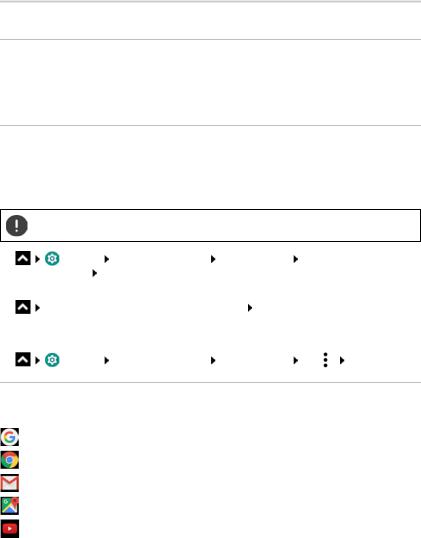
Apps
Installing/uninstalling apps
Installing new apps
Downloading apps from Google Play:
¤ 

 Play Store . . . The Google Play Store is opened
Play Store . . . The Google Play Store is opened  Look for the app you want
Look for the app you want  Open the app screen
Open the app screen  Install
Install
Uninstalling or disabling apps
You can delete apps you no longer need from the device.
You can uninstall apps you have downloaded. They are completely removed from the device. Apps preinstalled on the device (system apps) can be disabled but not completely removed. Disabled apps are not show on the device.
Disabling a system app can cause problems with other apps.
¤ |
Settings |
Apps & notifications |
Display all apps |
Select the app that you |
|
|
wish to uninstall |
Uninstall / Disable |
|
|
|
or (for apps which can be uninstalled) |
|
|
|
||
¤ |
Touch and hold the app you want to uninstall Drag it to Uninstall and release your |
||||
|
finger |
|
|
|
|
Show system apps and processes: |
|
|
|
||
¤ |
Settings |
Apps & notifications |
Display all apps |
Tap |
Show system |
Preinstalled default Google apps
The smartphone makes available many of the default apps from Google, including:
Search |
Browse Internet and search smartphone |
Chrome |
Browser for surfing on the Internet |
Gmail |
Receive, write and send emails |
Maps |
Look for and find out about places in all corners of the globe |
YouTube |
Play YouTube videos and playlists |
26
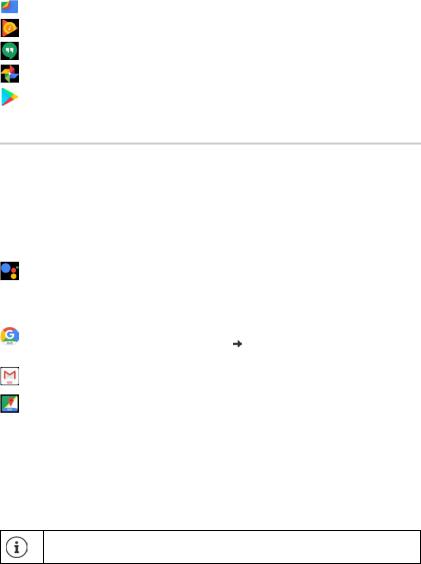
|
Apps |
Files |
File manager |
Play Music |
Listen to music |
Hangouts |
Communicate with friends with voice calls, messages and videos |
Photos |
Save and manage photos centrally |
Play Store |
Download apps |
More information on Google apps  Google Help
Google Help
Google Go
The Gigaset GS110 uses Android variant Go. Android Go was developed for smartphones with simple hardware configurations (low memory and processor performance), but offers users the full functionality of a current smartphone.
For smartphones with Android Go, there are standard Google apps as Go versions. These Google apps have been adapted such that they need little memory and require little mobile data.
The Google apps in question have “Go” after their name, such as
Google Assistant Go |
Enables simple communication with voice, with which you can |
|
have tasks performed with web searches or with local apps. Not |
|
possible in the Go version: Connection to external apps, control of |
|
smart home devices, entry of commands from the keyboard. |
|
Only an English version is available currently. |
Google Go |
The app bundles multiple Google functions, that are run with a |
|
reduced data volume ( p. 27). The most important is the Search |
|
function |
Gmail Go |
Receive, write and send emails like with Gmail. As a Go version |
|
with little memory requirement and even lower data usage. |
Google Maps Go |
Look for and find out about places in all corners of the globe. |
|
Some functions are not available in the Go version, such as Down- |
|
load offline map, measure distances between points, ... |
Apps for Android Go can also be installed on the Play Store.
Reduce data volumes when transferring from the web
¤Open Google Go 
 Tap
Tap  . . . The Settings menu is opened
. . . The Settings menu is opened  Use the switch to enable
Use the switch to enable
Use Lite mode . . . Your surf and search queries are routed via a Google proxy. Websites visited are compressed, and so data volumes reduced.
Data save mode is enabled permanently in Google Chrome.
27
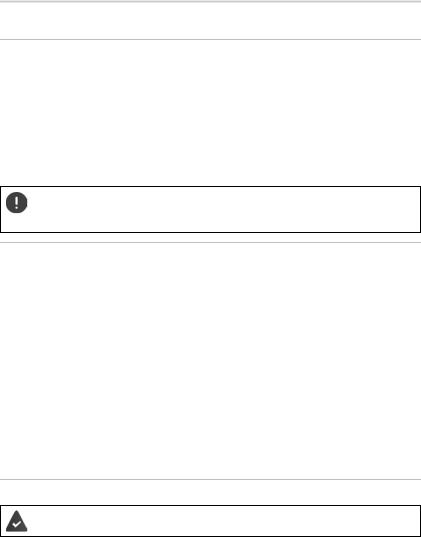
Apps
Protection from harmful apps
Downloading apps from sources other than Google Play
If you want to download apps from sources other than Google Play, you must permit it explicitly. You can find this function in the settings for the app that allows the download, e. g. browser or mail program.
¤ 

 Settings
Settings  Apps & notifications
Apps & notifications  Display all apps
Display all apps  Select the app that you wish to use to load apps from other sources
Select the app that you wish to use to load apps from other sources  Advanced
Advanced  Install unknown apps
Install unknown apps  Enable the Allow from this source switch.
Enable the Allow from this source switch.
If you intend to use apps that Google classifies as insecure, you must permit the use of such apps explicitly. Find out about the associated security risks from Google beforehand.
Apps from unknown sources can represent a security risk for your smartphone.
A download can corrupt your smartphone, and personal details can be misused or go missing.
Enabling Verify apps
When the function is enabled, your device verifies apps when being installed, and regularly searches the device for potentially harmful apps.
¤ 

 Settings
Settings  Google
Google  Security
Security  Google Play Project
Google Play Project 

 Enable the Scan device for security threats switch
Enable the Scan device for security threats switch
The following actions are possible when you install an app which is not from Google Play:
•Recommendation not to install the app.
•Installation of the app is blocked when there is a threat to the security of the device.
•Information on the app’s identification is sent to Google, such as protocol information, URLs connected to the app, the device ID, its operating system version and the IP address.
Apps installed on the device are checked regularly. If a potential harmful app is detected, the app check can take the following actions:
•Recommend that you uninstall the app immediately.
•Remove an app which is known to be insecure.
Improving the detection of harmful apps
The Scan device for security threats function is enabled.
If the function is enabled, Google also receives anonymous information on all apps installed which are not from the Google Play Store. This helps Google to provide better protection for users against harmful apps.
¤ 

 Settings
Settings  Google
Google  Security
Security  Google Play Project
Google Play Project 

 Enable the Improve harmful app detection switch
Enable the Improve harmful app detection switch
28
